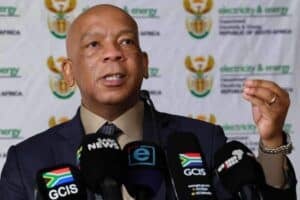Municipalities owe Eskom roughly R105 billion, while the debt owed by consumers to their municipalities is much lower.

The billions in debt owed to Eskom are more the fault of municipalities than of consumers, despite high electricity costs.
The Presidency’s specialist team tasked with addressing South Africa’s electricity situation made this assertion to the portfolio committee on electricity and energy as members questioned proposed recovery plans.
R105 billion is owed to Eskom, with the entity last week confirming to the same portfolio committee that roughly R62.2 billion of that would likely be written-off under new Distribution Agency Agreements (DDA).
The National Energy Crisis Committee (Necom) on Wednesday presented an update on its work to reform South Africa’s electricity distribution industry.
R40 billion in consumer debt
Portfolio Committee member and former Eskom CEO Brian Molefe questioned whether the debt levels were accurately compiled due to differences in accounting and distribution monitoring.
“While Eskom knows how much electricity it is delivering to municipalities, municipalities might not know what they are delivering to customers.
“Unless you can say without fear of contradiction that those systems are comparable on a back-to-back basis, and what you call municipal and what you call consumer debt to municipalities is accurately the same thing,” said Molefe.
He explained that living conditions for the majority of South Africans left the honouring of electricity bills a secondary concern.
On affordability, Necom’s Saul Musker said that free basic electricity subsidies were assisting low-income municipalities and stressed that municipalities with high payment rates were still heavily indebted.
“We have seen consumer debt to municipalities remaining quite significantly lower than municipal debt to Eskom.
“The debt that municipalities owe to Eskom, which is now over R105 billion, is accumulating more quickly than what consumers owe to municipalities, which is around R35 to R40 billion.
“It is a question of the efficiency of local government administrations and what they are spending electricity revenues on, as much as it is about payment from consumers,” Musker explained.
Questions on privatisation
Molefe then took aim at privatisation, stating the “new liberal paradigm” was only accessible to a select few.
“Where in the world has privatisation, which is the new liberal march in this sector, resolved the problem of unaffordability?
“Where has privatisation resolved the problem of poverty? Where has privatisation solved the problem of unemployment? How can you make a product more affordable by privatising?”, Molefe asked.
ALSO READ: In the market for a new home? Be sure to factor in this constantly escalating cost
Several reform plans focusing on “modernisation and stability” were are on the table, including the addition of competing agents.
“Wholesale electricity market reform is underway, and there will be multiple generators in future, although with Eskom still dominant,” Musker’s presentation stated.
Musker explained that Necom was not pushing for privatisation but that “distribution networks were natural monopolies” as only one could exist in any given area.
“It makes sense for distribution networks to be operated as public utilities and regulated monopolies,” he said.
“Even as competition is introduced, the intention is not to privatise the distribution assets, but to reform them so they delivered more efficiently,” said Musker.
‘Depends heavily on Nersa’
Necom’s presentation came after a presentation given by the National Energy Regulator of South Africa (Nersa) who outlined municipalities’ adherence to compliance requirements.
Eskom supplies 40% of South Africa’s municipalities directly, while 60% of municipalities are licenced electricity distributors.
In the 2024/25 financial, only 76 of the 178 municipalities submitted their cost of supply studies — reports that help determine tariff increase applications.
The worst performing municipalities showed the prevalence of high vacancy rates, as well as a lack of ringfenced business funds, load forecasting, bulk-payment Eskom accounts, and maintenance plans.
Necom highlighted six areas that it would work towards, but stated the onus was on Nersa to play a significant role.
“The reform journey depends heavily on Nersa introducing regulatory reform, tariff restructuring and building capacity – its lack of enforcement has resulted in a lack of consequence management,” Necom’s presentation stated.
For the 2025/26 financial year, Nersa received assistance from the South African Local Government Association and the Department of Cooperative Governance and Traditional Affairs in ensuring the cost of supply studies were completed.
This partnership has helped 177 of the 178 municipalities submit their studies to date.
NOW READ: Here is how many billions in municipal debt could be written off by Eskom






